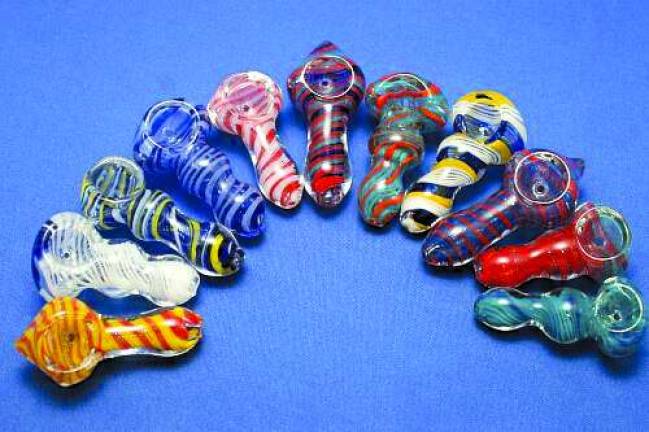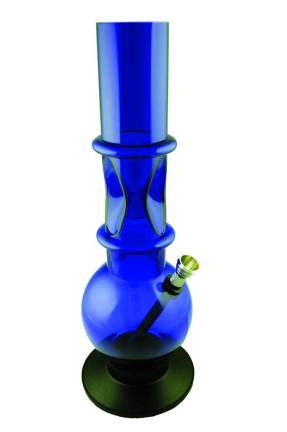Sale of tobacco, paraphernalia raises concern


BY HEMA EASLEY
CHESTER — The red electronic sign flashes at Tobacco Queen, inviting visitors to come in for a look. Inside, boxes of fragrant tobacco, cigars, hookahs and pipes line the neat store that sits next to a deli, a Freihofer bread outlet, and a popular restaurant.
A few miles away in neighboring Monroe is Pipe Dreams. The store sells no tobacco, only pipes — dazzling in their myriad colors, shapes and sizes, from glistening ceramic to metal to glass. Also on offer are electronic cigarettes and e-juices, which is liquid nicotine mixed with flavors like fudge brownie, blueberry and honeywood tobacco.
The manager, Matt Kalmus, proudly describes his clientele as smoking aficionados from the ages of 18 to 70.
Both stores are part of a resurgence in retailers selling tobacco or tobacco paraphernalia in the area. Never mind that fewer Americans now smoke cigarettes than they did a decade ago, and that some of the largest retailers, like CVS, are saying they won’t sell cigarettes anymore.
In fact, the Center for Disease Control says more high school students acknowledge smoking marijuana than cigarettes — 23 percent to 8 percent.
It seems tobacco stores are turning the law of supply and demand on its head.
Orange County, with a population of 374,000, has 344 tobacco retailers — about one for every 1,000 residents. Many of them include convenience stores, gas stations and drug stores.
Neighboring Pike County, with a population of $57,000, has 48 tobacco retailers.
'A ruse for other things'
John Zini, who runs Smoke & Puff on Route 17 in Monroe, said stores were selling loose tobacco because there was a demand for it. Loose tobacco is cheaper and does not invite the same heavy taxation that cigarettes do.
A pack of Marlboros is about $10 a pack. A pound of tobacco that sells for between $25 and $30 can make 20 packs of cigarettes, he said.
“People are trying to save money," Zini said. "That’s the honest thing."
But other items sold in his business and in many other tobacco retailers suggest another reason for their popularity. Prominently displayed on Smoke & Puff’s counter was a glass bong. Under the glass counter were an array of colorful ceramic pipes.
While these are apparently used for smoking tobacco, they can as easily be used for smoking marijuana and other herbs.
Matt Kalmus of Pipe Dreams explained how to use a ceramic pipe.
“You put your material in there,” Kalmus said, pointing to an indentation in the pipe. “We sell everything for tobacco. Legally that’s what we have to do.”
Leslie Hyatt, the principal of Chester Academy, wasn’t buying any of it.
“It’s a ruse for other things,” said Hyatt, who called for the community to rally to oust such stores. “They are selling drug paraphernalia.”
Michelle Murphy of Blooming Grove, an attorney and a mother of two, said she was aware of stores selling tobacco and paraphernalia but had not heard other parents voicing concern.
“It causes grave concern for me as a mother,” said Murphy, who is also a former council member on the Blooming Grove Town Board.
Murphy recalled that when she was in school, even middle schoolers were smoking cigarettes, and it was considered OK. Now, with a resurgence of tobacco retailers, it is once again easily accessible.
“It makes it seem that society is saying it’s OK,” said Murphy. Teens think “they are selling it in the store. How bad can it be?”
Thomas Carr, director of national policy for the American Lung Association, said the sale of artisanal or flavored tobacco products was a subtle marketing ploy to make them seem benign. But the risks are similar to smoking cigarettes because consumers are still inhaling something into their lungs, he said.
Yes, but is it legal?
Selling drug paraphernalia is illegal and can invite a fine of $5,000 and up to two years in prison. But proving that an item is paraphernalia is difficult because the same item can be used to smoke tobacco, which is legal.
A county official who asked not to be named said stores selling paraphernalia are legitimate businesses, and that law enforcement would not respond unless there something illegal was going on.
However, as the law is written, there is a very high bar to determining illegal conduct.
The Department of Justice defines drug paraphernalia as any item used to ingest or inhale marijuana, cocaine, hashish or hashish oil, among other contraband. These include metal, wooden, glass, stone or ceramic pipes as well as miniature spoons, bongs, water pipes and other equipment.
But to prove that an item is actually drug paraphernalia, it must be accompanied by literature describing its use, oral or written instructions, or testimony of a witness on its illegal use.
Stores are careful about keeping on the right side of the law. A sign at a Monroe store specifically warned buyers that if they made any reference to illegal activity they would be asked to leave, and photography was prohibited on the premises.
“They say you can’t use it illegally, but you know what it’s for,” said Murphy. “It’s like they are winking at you. Wink, wink.”
Principal Hyatt of the Chester Academy was convinced that the pipes and other equipment were a sign that stores were preparing for the legalization of marijuana.
Twenty states nationwide and the District of Columbia have legalized marijuana, either for medicinal or recreational purposes. Gov. Andrew Cuomo has also indicated he will allow for limited medical marijuana in the state.
Children “say it’s going to be legalized,” said Hyatt. “And you know they’re right. It’s really sad. It’s a sad time.”